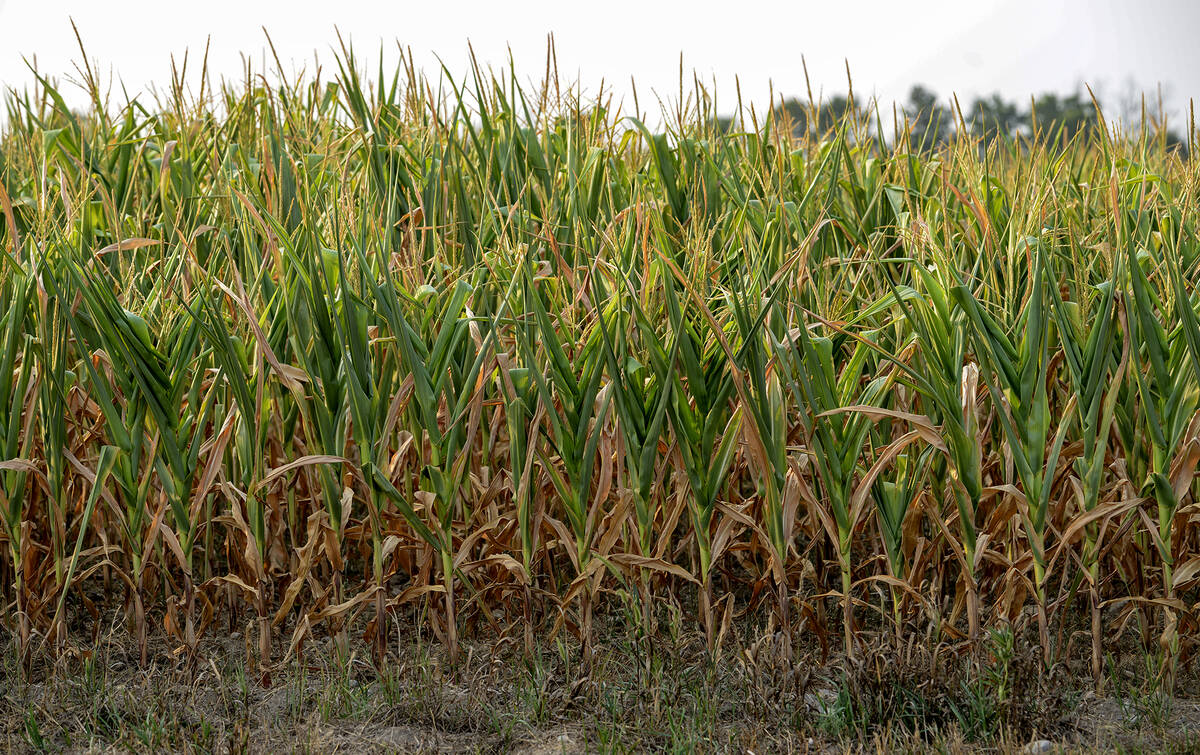Statistics Canada released its March 31 stocks report on May 6. Ontario on-farm corn, soybean and wheat stocks came in below year-ago levels. According to the Ontario Ministry of Agriculture, Food and Rural Affairs (OMAFRA), corn and soybean planting started the week of May 11. Our contacts in the province suggest that 80 to 85 per cent of the corn and soybeans will be in the ground by May 21.
Temperatures in Ontario were 3 to 4 C cooler than normal from April 14 to May 14. Most of the Ontario growing region received average precipitation in that time. York, Simcoe, Peel and Dufferin (Central West) counties only received 60 to 85 per cent of normal precipitation.
At this stage, we are forecasting average yields given the current planting time frame and weather conditions. We’re rating the winter wheat 65 per cent good to excellent, 25 per cent fair and 10 per cent poor as of May 15. Statistics Canada’s crop survey earlier in April stated winter wheat remaining this spring was 90 per cent of the total planted acres last fall, down from the year-ago level 96 per cent. Comments suggest the winter wheat remaining may be only about 83 per cent of total planted acres with some farmers replanting winter wheat acres into spring wheat.
Read Also

Extreme variability marks Ontario’s 2025 corn crop
The yield potential of Ontario’s 2025 corn crop was lost in some areas due to extreme dry conditions.
Quick look
- Soybeans: Old-crop premiums will begin to diminish and farmers should sell remaining old crop and not hold on until summer.
- Corn: Trade flows and a potential summer rally will hinge on U.S. production.
- Wheat: Due to many uncertainties in the world now, it’s best to sell regular increments throughout the crop year.
Corn and soybean markets are digesting the U.S. Department of Agriculture’s May World Agriculture Supply and Demand Estimates (WASDE) report. U.S. corn production is projected at 367.3 million tonnes, down 16.6 million tonnes from last year. U.S. soybean production is expected to reach 126.3 million tonnes, up nearly six million tonnes from year-ago levels. Planting progress is lagging in North Dakota, which may lower planted acreage for the row crops.
The harvest of Brazil’s second crop will move into high gear during June. Argentine farmers are in the final stages of the soybean harvest and about 40 per cent of the total corn crop is in the bin. The harvest of second phase Argentine corn production extends into August.
The wheat market remains sensitive to developments in Russia and Ukraine. The WASDE report was considered bullish for the wheat market due to lower winter wheat production. India has implemented a ban on wheat exports starting in July but would allow exports to countries most in need of food. Higher prices for wheat tend to fuel trade restrictions among developing countries. Northern Europe and North Africa are on the drier side.
The U.S. Federal Reserve and the Bank of Canada will raise rates in tandem. However, quantitative tightening (bond or treasury liquidation from the balance sheet) by the U.S. Federal Reserve will be more aggressive compared to the Bank of Canada. This will favour U.S. dollar strength over the Canadian dollar through summer.
Soybeans
Ontario on-farm soybean stocks as of March 31 were 680,000 tonnes, down from the year-ago level of 760,000 tonnes. We’re projecting on-farm stocks to drop to 7,000 tonnes by the end of July, which is unchanged from the July 31 onfarm supplies. This is considered bin bottom levels.
The function of the domestic market is to ration demand. Prices from domestic crushers will continue to exceed elevators sourcing for the export market because of tight stocks. Basis levels will remain firm but it’s important to note that crushers take their downtime for maintenance and upgrades during August. At the time of writing this article, Ontario old crop soybean prices were at a $2.50 per bushel premium to new crop. This premium will erode as we approach new crop positions. The market is telling producers to sell old crop soybeans now instead of holding into the summer. We’re now projecting Ontario soybean production for the 2022/23 crop year to reach 4.1 million tonnes, unchanged from last year.
The WASDE report was considered bearish for the soybean market. U.S. farmers are expected to harvest 126.3 million tonnes of soybeans this fall, up from the 2021 output of 120.7 million tonnes. Given the demand projections, the U.S. carryout for the 2022/23 crop year will finish at 8.4 million tonnes, up from the 2021-22 ending stocks of 6.4 million tonnes.
Brazilian production was left unchanged at 125 million tonnes, down from last year’s crop size of 139.5 million tonnes. Argentine output was lowered by 1.5 million tonnes from last month to 42 million tonnes. This compares to last year’s Argentine crop of 46.2 million tonnes. Lower South American estimates have been factored into the market since Brazil’s harvest finished earlier. Argentina is a large exporter of meal and oil but not soybeans. Traders are focused on U.S. output at this stage.
Soybean offers out of the Gulf are in line with Brazilian offers out of Paranagua for June and July. For October and November, U.S. offers are more competitive. Argentina and Brazil will have a combined carryout of 40 million tonnes. There are large stocks weighing on the market, limiting the upside.
What to do: We’ve advised Ontario farmers to be 100 per cent sold on old crop soybeans and 10 to 15 per cent sold on new crop. Let’s be patient to make sales until the crop is more certain. We eventually want to be at 20 per cent sold for harvest movement.
Corn
Ontario farmers were holding three million tonnes of corn on March 31, down from 3.4 million tonnes on March 31, 2021. Total domestic disappearance in Ontario from Jan. 1 through March 31, 2022, was 1.3 million tonnes, down from 1.8 million tonnes last year. Domestic demand doesn’t appear to be as strong as in past years. Exports have picked up over the month with the lakes opening. Canadian crop year-to-date exports for the week ending May 8 were 1.2 million tonnes, up from 0.9 million tonnes last year. The larger export pace partially offset the year-over-year decline in domestic demand.
Lower exports from Ukraine have enhanced European demand for Ontario corn. The main destinations have been Ireland and Spain. The European feed grains market is contending with tighter supplies of feed grains and drier conditions in Northern Europe have caused the coarse grain market to strengthen.
There were no changes to Argentine and Brazilian corn production on the May WASDE report. Argentine corn output was estimated at 53 million tonnes, up from 52 million tonnes last year. Brazilian corn production was projected to come in at 116 million tonnes, up from 87 million tonnes last year. It’s important to note that Brazilian exports were estimated at 44.5 million tonnes, up from 21 million tonnes last year. This will offset the decline in exports from Brazil. There is no shortage of corn but only a difference in world trade flow. World ending stocks less China will be similar to year-ago levels.
Having said that, it all hinges on a decent U.S. crop. USDA used an average yield of 177 bu./ acre to forecast a U.S. crop size of 367 million tonnes, down 16.6 million tonnes from last year. Without going into details of demand, USDA is projecting a U.S. carryout of 34.5 million tonnes, down from the 2021-22 ending stocks of 36.6 million tonnes.
If production drops four to five million tonnes, the market will function for acute demand rationing. Unlike soybeans, the combined Brazilian and Argentine corn carryout is only about six million tonnes. There is no excess stock of corn in South America so the market must trade high enough to curb use.
What to do: We’ve advised farmers to be 100 per cent sold on old crop corn and 10 per cent sold on expected new crop production. There is potential for the corn market to incorporate a risk premium due to the uncertainty in U.S. production. We’ll add onto sales if the corn rallies during the summer.
Wheat
Ontario on-farm wheat stocks as of March 31 were 230,000 tonnes, down from 242,000 tonnes on March 31 of 2021. Higher prices have enhanced export demand for the remainder of the 2021-22 crop year. Ontario on-farm wheat stocks are expected to drop to 25,000 tonnes at the end of the crop year, which would be one of the lowest carry-outs on record for Ontario. Domestic millers have the bulk of their old crop demand covered but limited ownership for new crop. Basis levels will likely remain firm until the harvest period.
Ontario farmers planted 930,000 acres of winter wheat last fall. According to Statistics Canada, there were 844,000 acres remaining this spring. Our contacts suggest that winter wheat acres remaining are closer to 800,000 acres. We’re now forecasting Ontario winter wheat production to be 1.85 million tonnes, down 100,000 tonnes from our estimate last month and down 821,000 tonnes from last year.
Ontario prices are largely influenced by the U.S. fundamentals and to a lesser extent other major exporters. U.S. hard red winter wheat production is now expected to finish in the range of 15 to 16 million tonnes, down from our earlier estimate of 17 million tonnes and down from the 2021 crop size of 20.4 million tonnes. It’s important to note that U.S. domestic food usage of hard red winter wheat is approximately 10 million tonnes per year. The hard red winter carryout is expected to drop to three million tonnes. This compares to the 2007-08 ending stocks of 3.7 million tonnes. The large domestic usage causes the domestic market to trade at a premium to world values. Prices from Ontario millers will also be premium to the world market during the first half of the 2022-23 crop year or until they have the bulk of total demand covered.
In Europe, France and Germany are experiencing drier conditions, resulting in lower production forecasts. In our previous issue, European soft wheat output (wheat excluding durum) was estimated at 130 million tonnes. However, we’re not expecting the crop to finish around 120 million tonnes. Last year’s European soft wheat crop was also 130 million tonnes. There is no change to Russian production forecasts, which range from 84 to 88 million tonnes, up from 75 million tonnes last year. More importantly, USDA sees Ukraine output at 21.5 million tonnes, down from 33 million tonnes last year. Ukraine exports have potential to reach 10 million tonnes, down from the 2021-22 forecast of 19 million tonnes. Ukraine fundamentals are a best guess at this stage.
What to do: We’ve advised Ontario farmers to be 100 per cent sold on old crop. This week, we’re advising farmers to sell 10 per cent of expected new crop production. There are many uncertainties in the world and issues that we cannot forecast. When it comes to wheat, the best one can do is sell regular increments throughout the crop year. Current prices justify starting sales.
Jerry Klassen is a market analyst for Resilient Capital.













